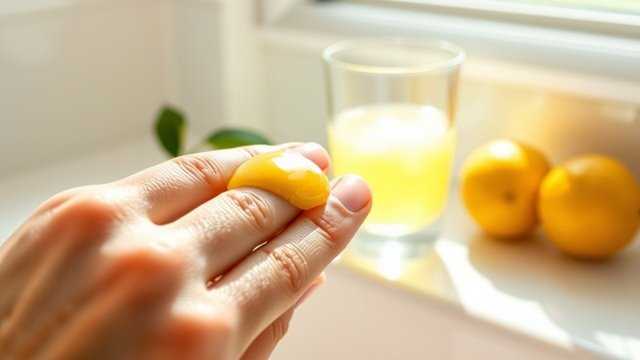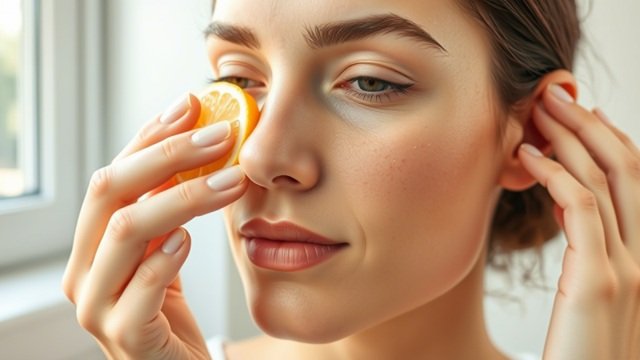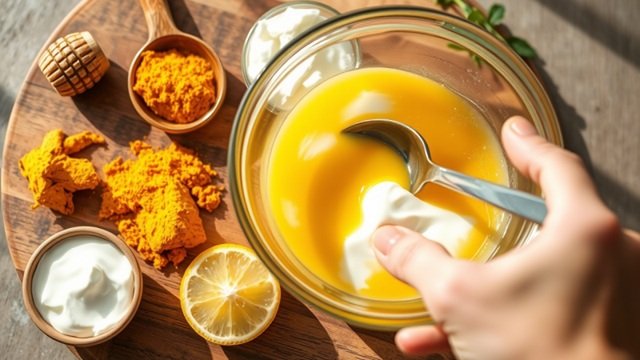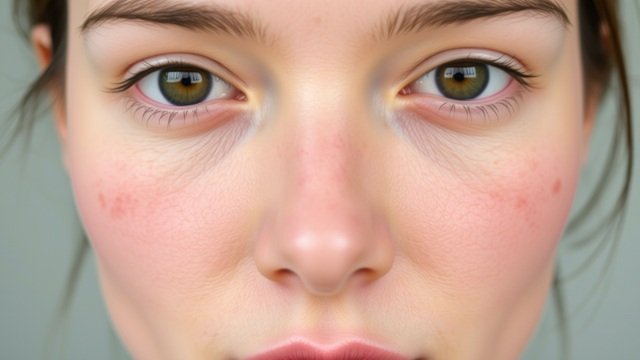Introduction to wellhealthorganic.com : Remove Dark Spots on Face Tang – Lemon Juice
Introduction
Dark spots—those small, stubborn patches that linger long after acne, sunburns, or hormonal changes—are a common skin concern for millions. These blemishes, also known as hyperpigmentation, can make skin appear uneven and dull, prompting many to search for solutions that are both effective and natural. Chemical treatments and laser procedures exist, but they’re not always accessible, affordable, or gentle on the skin. That’s why natural remedies continue to gain popularity, especially when they use common household ingredients.
One such home remedy, gaining attention thanks to insights shared on wellhealthorganic.com, combines two surprisingly effective ingredients: Tang powder and lemon juice. While this combo might sound more like a kitchen experiment than a skincare solution, its potential to gently fade dark spots has intrigued many. With their exfoliating and brightening properties, Tang and lemon juice may offer a budget-friendly, easy-to-make alternative to commercial treatments. In this article, we’ll break down how this remedy works, how to use it safely, and what to expect.
Table of Contents
What Are Dark Spots and Why Do They Appear?
Dark spots, or hyperpigmentation, form when excess melanin—the pigment responsible for skin color—is produced in certain areas of the skin. Melanin production is triggered by a range of factors. One of the most common culprits is excessive sun exposure, which prompts the skin to produce melanin as a defense mechanism. Over time, this can lead to sunspots, particularly on the face, hands, and shoulders. Acne scars are another major cause. When a pimple heals, it can leave behind a mark that lingers due to inflammation and increased melanin production in that spot.
Aging also plays a significant role; as we grow older, the skin’s ability to regenerate slows down, and pigmentation can accumulate more easily. Environmental factors like pollution, lifestyle habits, and poor skincare routines—such as not removing makeup, using harsh products, or skipping sunscreen—can all contribute. Hormonal changes, especially during pregnancy or from birth control, may cause melasma, a form of dark spots. The buildup of dead skin cells also dulls the complexion, creating an uneven tone. In short, dark spots are a complex issue with multiple causes, and addressing them often requires both internal balance and external care.
Benefits of Lemon Juice for the Skin

Lemon juice is a powerhouse in natural skincare, thanks largely to its high vitamin C content. This antioxidant not only helps protect the skin from free radical damage but also plays a vital role in collagen production, which keeps the skin firm and youthful. When it comes to dark spots, vitamin C helps lighten hyperpigmentation by inhibiting melanin production in the skin. Over time, consistent use can result in a brighter and more even skin tone.
But the benefits don’t stop there. Lemon juice is also rich in citric acid, a natural AHA (alpha hydroxy acid) that gently exfoliates the skin. This means it helps remove the outer layer of dead skin cells, revealing the fresher, lighter skin underneath. It can also unclog pores, reduce excess oil, and give the skin a smoother texture. This makes lemon juice especially helpful for people dealing with both dark spots and acne. However, because it’s acidic, it must be used with care to avoid irritation, dryness, or sensitivity, especially when exposed to sunlight. Still, when diluted or paired with complementary ingredients, lemon juice can be an effective and affordable brightening agent.
How Tang Works as a Skin Brightening Agent
Tang, a fruit-flavored drink mix, may not be the first thing that comes to mind for skincare—but surprisingly, it has components that make it a quirky yet functional ingredient for DIY skin treatments. The primary ingredient of Tang is citric acid, which, like in lemon juice, acts as a gentle exfoliant. When applied to the skin, this acid helps slough off dead cells, encouraging cell turnover and revealing newer, healthier skin underneath. Tang also contains sugar, which works as a mild scrub when mixed into a paste, further aiding exfoliation.
In addition to citric acid and sugar, Tang is enriched with artificial fruit flavors and sometimes even vitamin C fortification. These ingredients contribute to a temporary glow and softness when used carefully. While not designed for topical use, some DIY enthusiasts have discovered that, in moderation, Tang can mimic the effects of a light fruit peel, improving dullness and making the skin look more refreshed. It’s important to note that this isn’t a conventional method, and users should always be cautious when experimenting with non-skincare products. That said, when blended with lemon juice, Tang offers a layered approach to exfoliation and brightness—an interesting twist on traditional natural remedies.
How to Prepare Tang and Lemon Juice Mask at Home
Creating your own Tang and lemon juice mask at home is simple, quick, and inexpensive—but it’s important to follow the process carefully to avoid irritation. First, gather your ingredients. You’ll need 1 tablespoon of Tang powder and 1 tablespoon of freshly squeezed lemon juice. For added nourishment and to reduce potential dryness, you can include half a tablespoon of honey or plain yogurt. These optional ingredients help soothe the skin and add moisture, making the mask more suitable for sensitive or dry skin types.
Start by mixing the Tang powder and lemon juice in a small bowl. Stir thoroughly until you achieve a smooth, paste-like consistency. If using honey or yogurt, add it to the mixture and blend evenly. Once the mask is ready, cleanse your face with a gentle face wash to remove any dirt or oil. Pat your skin dry, and using clean fingers or a brush, apply the mask evenly across the face, avoiding the eye area and any open wounds or active acne.
Let the mask sit for 10 to 15 minutes. You might feel a slight tingling sensation—this is normal due to the citric acid. However, if it burns or stings excessively, rinse it off immediately. After the recommended time, wash off the mask with lukewarm water, gently massaging in circular motions to enhance exfoliation. Pat your skin dry with a soft towel and follow up with a moisturizer to restore hydration. For best results, use this mask 2 to 3 times per week, ideally in the evening, to avoid sun exposure right after treatment.
Tips to Maximize Results from This Natural Remedy

To get the most out of the Tang and lemon juice mask, it’s essential to use it smartly and consistently. Always start with a patch test on a small area of your skin, like your wrist or jawline, to ensure you don’t have an adverse reaction. Since both lemon and Tang contain acids that increase photosensitivity, apply the mask in the evening, and always use broad-spectrum sunscreen the following morning to protect your skin. Skipping this step can worsen dark spots instead of improving them.
After rinsing off the mask, apply a gentle moisturizer to replenish your skin’s moisture barrier. Ingredients like aloe vera, hyaluronic acid, or ceramides are ideal post-treatment. Consistency is key—don’t expect results after one or two uses. It may take several weeks of regular application to see visible improvement. Track your progress, and if irritation occurs, reduce frequency. This natural remedy works best as part of a well-rounded skincare routine that includes hydration, sun protection, and a healthy diet.
Precautions to Consider Before Using Tang and Lemon on Your Face
While this DIY treatment is natural and cost-effective, it’s not suitable for everyone. Lemon juice is highly acidic and can irritate the skin, especially if used too often or left on too long. It can cause dryness, redness, and heightened sensitivity to sunlight. Tang, though effective in exfoliation, contains sugar and artificial additives that may clog pores or worsen acne-prone skin if not rinsed thoroughly.
Avoid using this mask on broken, inflamed, or sensitive skin, and never apply it to sunburned areas. If you have a history of skin allergies or conditions like eczema or rosacea, consult a dermatologist before trying this remedy. Also, refrain from using it daily—over-exfoliation can damage the skin barrier and lead to more issues. Natural doesn’t always mean harmless, so always err on the side of caution.
Other Natural Alternatives for Dark Spot Removal

If Tang and lemon juice aren’t for you, there are several other gentle, natural alternatives worth trying. Aloe vera gel is known for its soothing and healing properties. It helps reduce inflammation and gradually fades pigmentation with consistent use. Turmeric mixed with milk creates a powerful anti-inflammatory paste that lightens dark spots while calming the skin. Another favorite is green tea toner; green tea is rich in antioxidants and helps detox the skin while minimizing discoloration. Lastly, papaya pulp contains natural enzymes like papain that exfoliate dead skin and brighten the complexion.
Each of these ingredients has been used in traditional skincare for generations, and while their effects are gradual, they are generally safe and nourishing for the skin. You can alternate between them or combine them in rotation for a comprehensive natural skincare routine.
Frequently Asked Questions (FAQs)
Can I use tang and lemon juice daily?
No, daily use is not recommended. Both ingredients are acidic and exfoliating, and daily application can lead to irritation, redness, or even long-term damage to the skin barrier. For best results, use the mask 2 to 3 times a week, allowing your skin time to recover and regenerate between uses.
How long does it take to remove dark spots naturally?
Natural remedies require patience. You may start to notice mild improvements after 3–4 weeks of consistent use, but significant fading of dark spots can take anywhere from 2 to 3 months. This varies based on skin type, the severity of pigmentation, and overall skincare habits. Staying consistent and protecting your skin from the sun will speed up the results.
Is this remedy suitable for sensitive skin?
Sensitive skin types should be cautious. The acidity of lemon and the additives in Tang can cause irritation. It’s best to add a soothing agent like honey or yogurt and do a patch test first. If you experience burning or redness, discontinue use. Consulting a dermatologist is advised before starting any new treatment on sensitive skin.
What should I apply after using this mask?
After rinsing off the mask, it’s crucial to apply a gentle, hydrating moisturizer to calm the skin. Look for ingredients like aloe vera, glycerin, or hyaluronic acid. Also, if you used the mask in the evening, apply sunscreen the next morning. This step is non-negotiable, as exfoliated skin is more vulnerable to sun damage.
Can I mix tang and lemon with other ingredients?
Yes, and doing so can make the mask more effective and gentle. Ingredients like honey, yogurt, or aloe vera gel can balance the acidity, soothe irritation, and add extra skin benefits. Experimenting with combinations can help tailor the mask to your skin’s needs, but always patch test first.
Conclusion
Using Tang and lemon juice as a natural remedy for dark spots may sound unconventional, but when used carefully and consistently, it can help lighten pigmentation and reveal a more radiant complexion. Inspired by natural beauty tips from wellhealthorganic.com : remove dark spots on face tang – lemon juice, this simple mask blends exfoliation and brightening in a way that’s both accessible and affordable. Just remember: results take time, skin types vary, and even natural ingredients need to be handled with care. While this remedy can be a great addition to your skincare routine, it’s not a substitute for professional advice. Keep track of your progress, protect your skin with sunscreen, and use what works best for your unique skin.
Read More Blogs – Gennady Yagupov: Moving Container Safety Tips for Families


